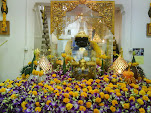that is made by the monks in certain Wats (Buddhist temples) to commemorate special events,festivals, or an anniversary.
For centuries, the monks have been crafting these little treasures. They come in all shapes and sizes, but generally, each Wat makes its own particular shape and size. Each amulet is infused with prayers, secret ingredients, and a little magic. They are said to endow their wearer with special powers, even up to the point of making the owner indestructable, and able to strike mortal terror into the heart of his enemies. Others are made to attract love, success, or happiness.
Possibly the oldest Thai amulets whose origins are traceable are the amulets from the Haripunchai period. Today this area is known as Lampoon province. Around 1,200 - 1,400 years ago there was a strong Mon/Burmese influence here and this area was its own distinct kingdom.
The first Thai amulets where made and blessed by devout monks and given to warriors and fighters to enhance and strengthen their ability to fight the enemies of Thailand. Many times the Thai amulets were worn as buttons or as talismans. This power then and today was acquired through a faith in the power of the Buddha and as protection against their enemies to be beaten, injured or killed in battle. Although the names of the kingdoms have changed and we have a host of new monks, the power and the belief in magical attributes of these Thai amulets remains very strong.
The collecting of these images is serious business in thailand. Great care is used to determine the age and authenticity of each piece. The most famous is the "Benjapakee" or "The Grand 5 Set".
The motif images of Thai Buddhist amulets were usually the Buddha, it was until the past century when images of Arahants (disciples of Buddha whom had achieved Nibbana), famous monks and Devas gained much more popularity. In fact, the Buddha had forbidden the worship of his images in attempt to achieve enlightenment, but rather achieve enlightenment through practising the Dhamma. The worship of Buddha's images may also lead to the wrong practise of worshipping idols instead of practising and understanding the Dhamma. No images of the Buddha were made during the life of the Buddha, and after the Buddha's passing away, Buddhist paid respect to the Buddha's relics, Stupas and to his footprints.
Thai Buddhist amulets are made by monks from since the last century. As mentioned earlier, the majority Thai Buddhist amulets depicts the image of the Buddha, however images of Arahants, popular monks and Devas had also gained popularity in recent decades, especially the images of popular holy monks. These images often bear words from Buddhist scriptures written or inscribed in old Khymer language scripts and contemporary Thai language scripts. The name of the particular monk and temple making and commissioning the amulet are oftenly also included on the amulet, along with the date it was made and issued. Yantra scripts and other Buddhist symbols such as images of Stupas, Bodhi leave, etc, are also oftenly included on the amulet.New period of Thai Buddhist images are made for a few purposes other than for Stupa storage, some common purposes are; to rise funds for the purposes of temple building or repair, fund rising for building hospitals, orphanages, etc.
胡


No comments:
Post a Comment